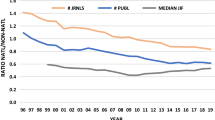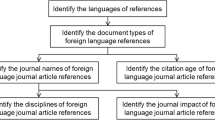Abstract
In this study we compare internationalization of academic journals in six fields of science. Internationalization was investigated through journals’ concentration on publishing papers from particular countries, relationship between the geographical distributions of editors and authors, and relationship between language of publication and the geographical distribution of papers. Having analyzed more than 1,000 journals we can state that social sciences literature in the fields considered is still nationally and linguistically fragmented more than natural sciences literature, but in some cases the gap is not so big. One of the consequences concerning research output assessment is that usefulness of international databases having national disparity in coverage is still limited in social sciences.






Similar content being viewed by others
Notes
There are several publications, included in JCR Science Edition 2011, which have empty Impact Factor cells.
The use of the Impact Factor quartiles for classifying journals by impact level is a common technique, but when the validity of classification is crucial, for example in national research evaluation systems, this approach is contested (e.g. Garcia et al. 2012).
In The World Factbook languages for each country are ordered starting with the largest in terms of the percent of speakers in total population.
Only journals indexed in WoS throughout 2002–2011 were included in this analysis.
In this study "board member was operationally defined as an international member if his/her institutional affiliation was in a different country than the journal’s primary place of publication".
The home country of the journal was measured in this study as the country of affiliation of the editor.
Let us repeat, as this terminology can be confusing, that we did not check the authors' countries of origin to decide what languages are native and foreign for them. Rather we checked their institutional affiliations. If any of the authors of an English-language paper works in some English-speaking country we assign this paper to a "native language" group.
This particular publication shows that for a journal to have a high share of papers written in a foreign language is not the same as to be highly international. The journal is published in English, but it has some traits of national-oriented, in this case Lithuanian-oriented, publication. Its prominent position in the Impact Factor rating (12th among 317 journals) to a large extent is provided by citations from other Lithuanian publications.
References
Archambault, E., Vignola-Gagne, E., Côté, G., Larivière, V., & Gingras, Y. (2006). Benchmarking scientific output in the social sciences and humanities: the limits of existing databases. Scientometrics, 68(3), 329–342.
de Moya-Anegon, F., Chinchilla-Rodriguez, Z., Vargas-Quesada, B., Corera-Alvarez, E., Munoz-Fernandez, F. J., Gonzalez-Molina, A., et al. (2007). Coverage analysis of Scopus: A metric approach. Scientometrics, 73(1), 53–78.
Engels, T. C. E., Ossenblok, T. L. B., & Spruyt, E. H. J. (2012). Changing publication patterns in the Social Sciences and Humanities, 2000–2009. Scientometrics, 93(2), 373–390.
Garcia, J. A., Rodriguez-Sanchez, R., Fdez-Valdivia, J., & Martinez-Baena, J. (2012). On first quartile journals which are not of highest impact. Scientometrics, 90(3), 925–943.
Gorraiz, J., Greil, M., Mayer, W., Reimann, R., & Schiebel, E. (2009). International publication output and research impact in social sciences: comparison of the Universities of Vienna, Zurich and Oslo. Research Evaluation, 18(3), 221–232.
Harzing, A.-W., & Metz, I. (2013). Practicing what we preach. Management International Review, 53(2), 169–187.
Hicks, D. (1999). The difficulty of achieving full coverage of international social science literature and the bibliometric consequences. Scientometrics, 44(2), 193–215.
Hicks, D., & Wang, J. (2011). Coverage and overlap of the new social sciences and humanities journal lists. Journal of the American Society for Information Science and Technology, 62(2), 284–294.
Huang, M., & Chang, Y. (2008). Characteristics of research output in social sciences and humanities: from a research evaluation perspective. Journal of the American Society for Information Science and Technology, 59(11), 1819–1828.
Kyvik, S. (2003). Changing trends in publishing behaviour among university faculty, 1980–2000. Scientometrics, 58(1), 35–48.
Larivière, V., Archambault, E., Gingras, Y., & Vignola-Gagné, E. (2006). The place of serials in referencing practices: Comparing natural sciences and engineering with social sciences and humanities. Journal of the American Society for Information Science and Technology, 57(8), 997–1004.
Nederhof, A. (2006). Bibliometric monitoring of research performance in the Social Sciences and the Humanities: A review. Scientometrics, 66(1), 81–100.
Nisonger, T. E. (2002). The relationship between international editorial board composition and citation measures in political science, business, and genetics journals. Scientometrics, 54(2), 257–268.
Norris, M., & Oppenheim, C. (2007). Comparing alternatives to the Web of Science for coverage of the social sciences’ literature. Journal of Informetrics, 1(2), 161–169.
Savelieva, I. M., & Poletayev, A. V. (2009). Publications of Russian authors in foreign journals in social sciences and humanities in 1993–2008: Quantity and quality: working paper P6/2009/02. Moscow: State University—Higher School of Economics. (in Russian).
Van Noorden, R. (2012). Science on the move. Nature, 490(7420), 326–329.
Vieira, E. S., & Gomes, J. A. N. F. (2009). A comparison of Scopus and Web of Science for a typical university. Scientometrics, 81(2), 587–600.
Zitt, M., Ramanana-Rahary, S., & Bassecoulard, E. (2003). Correcting glasses help fair comparisons in international science landscape: Country indicators as a function of ISI database delineation. Scientometrics, 56(2), 259–282.
Acknowledgment
This study was carried out within “The National Research University Higher School of Economics’ Academic Fund Program in 2012–2013, research Grant No. 11-01-0037”.
Author information
Authors and Affiliations
Corresponding author
Rights and permissions
About this article
Cite this article
Dyachenko, E.L. Internationalization of academic journals: Is there still a gap between social and natural sciences?. Scientometrics 101, 241–255 (2014). https://doi.org/10.1007/s11192-014-1357-9
Received:
Published:
Issue Date:
DOI: https://doi.org/10.1007/s11192-014-1357-9




